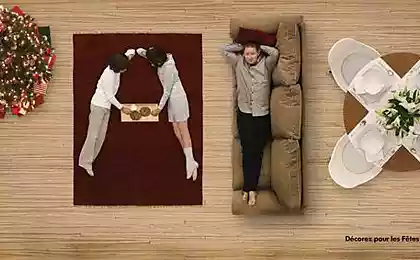768
Solar facts (photo + 8 letters)
Quick answer - which star in the sky is the brightest?
The most advanced can answer - Sirius.
The answer is not entirely true, because Sirius is the brightest star in the night sky, and the day is, of course, the sun!
Sun - one of many stars in our galaxy, more or less commonplace (more on that later), but feature him in close proximity, which is why it is not only light, but also warms us, and even look at him without the safety devices is dangerous (this is also below).
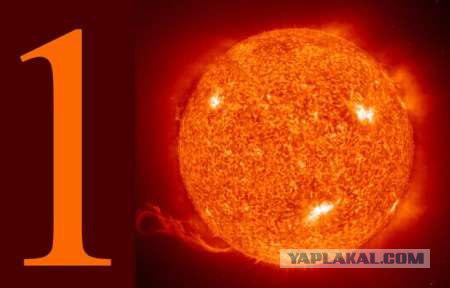
If you look at the sun, you can go blind. This tells us a child mother, father, relatives and friends: do not look at the sun, go blind! Actually, that's not true. To be exact, no one was blind, completely and forever, just looking at the sun. You can damage your eyes, but with the help of medications and special exercises vision largely restored. In addition, the most harmful to look at the sun during a total eclipse it, not when it shines with full force. It is dangerous to look at the sun without protection at the time immediately after the eclipse - when the light is completely covered by the Moon, the pupil increases, allowing more light into the eye, and if at this point sharply breaks first bright beam of light, you can get damage to the retina - solar retinopathy. It does not influence the thermal and photochemical when exposed to ultraviolet light flow through the pupil as open as possible is a chemical destruction of the cells of the retina. But even this harm can be eliminated with the help of medicine, almost completely restore vision in most cases. The risk in this regard are primarily children due to the nature of the structure of the lens of children's eyes (he transmits more blue light, the lens yellows with age, becoming a natural filter UV). For those of you who are determined to test and disprove the assertion of the impossibility of going blind staring at the sun, I can advise to use binoculars or a telescope - it will be more reliable, and if "lucky", you can get a premium Darwin
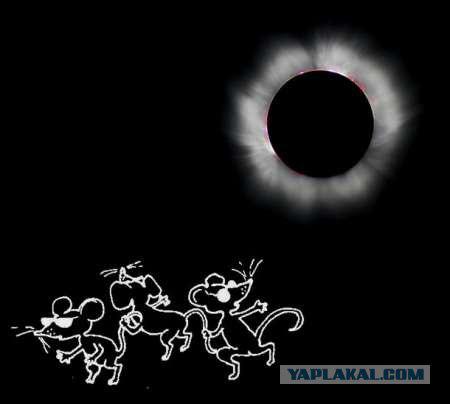
Sun - the most common star. Or not? Despite the fact that in recent years with the development of technology, many believe it is a 100% fact, actually the sun is different from the other stars in the galaxy. If you compare the lot of stars, they have one thing in common - they all have a spherical shape, more or less correct. However, they differ in size, temperature, color, luminance and other characteristics. All these different characteristics are the result of just one factor - mass. Weight stars defines all the parameters of the star - the size, the color, the term of her life, etc. Stars with low mass (less than half of the Sun), cold, dull, their color is closer to red, with a long life. Stars whose mass is 10-20 times larger than the Sun, mostly bright blue, very bright, but for a couple of million years, "burned" completely. The percentage of supermassive stars in the Galaxy can be counted on the fingers, a much more massive, and "small" - countless. Our Sun is then in the middle of the scale, and it is more massive than 80% of all stars in our Galaxy. Of course, if you look at the left drawing the title of the item, we can see that compared to the red giant Aldebaran sun looks like a dwarf, but such whoppers in the universe is a unit, so the right side of the figure, where the sun is compared to the more common brown dwarf (Star Style) to be more honest, because of dwarfs around us in the universe is the vast majority. Simply put, 90 percent of the stars that can be seen in the night sky, less dimmer and cooler than the sun.
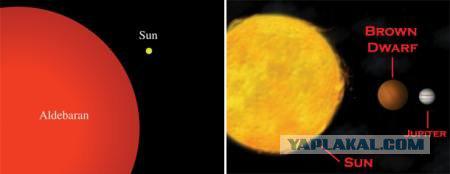
So, the sun bright and large. Why is this so? What makes the sun is shining and warm, so much so that in the world at the same time the heat is 35 degrees in the shade? All the matter in the equation of Albert Einstein, E = mc2, according to which the conversion of the substance in en mass of the Sun is a million times the mass of Earth, the pressure at the center of more than 340 billion atmospheres, the temperature of 16 million degrees Celsius. Under these conditions inside the Sun occurs nuclear fusion, in which hydrogen is converted into helium - the same processes occur in the hydrogen bomb. However, there is only enough hydrogen out to inflate the balloon, and imagine what the reaction of burn millions of tons of matter ... When the hydrogen is converted into helium, the mass of matter is converted into energy that heats the sun. According to calculations, every second in the interior of the sun is converted into the energy of matter 5 million tons of material - a mass of seven fully loaded supertankers. More specifically, of the 700 million tons of hydrogen per second produced 695 tons of helium, and the missing 5 million tons of matter are transformed into 400,000,000,000,000,000,000,000,000 joules of energy, reducing the mass of the Sun on 0.00000000000000000025%. So in the next billion years, the Sun shortage of fuel is not threatened.
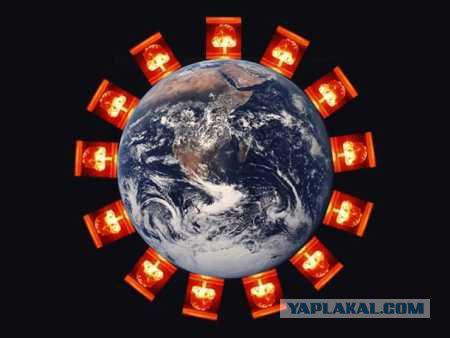
The sun is not visible from a distance of 60 light years. Despite all the turbulent energy and activity in its depths, and the unbearable brightness of our light can not be seen with the naked eye in the sky, if you fly off from it at some 60 light-years. In astronomy for the observed brightness of the star is the concept of magnitude, the minimum value of which, visible eye is 6. The higher the number, the more dim starlight. For example, the full moon has a value of minus 13, minus 4 Venus, one of the brightest stars - Vega has magnitude 0, Polaris - 2. The farther away from the object, the less bright it is visible in the sky. The brightness of the sun drops to sixth magnitude at a distance of 60 light years, or 600 billion kilometers. It is very far in human terms, but the scale of the universe is within arm's length. For comparison - the diameter of the Milky Way's 100,000 light-years, or 1, 000, 000, 000, 000, 000, 000 kilometers. The image of the Milky Way at the top 60 light years is less than half the pixels (dots on the screen).
The galaxy is huge. If you look at the sky at night, nearly all the stars that you see, are less than 100 light years from Earth, and only a few of them are so bright that "finishing off" from a greater distance. So if you put the sun in a random place of the universe, then the probability of 99.99999% to the naked eye will find it impossible.

What color is the sun? Many others will respond - yellow. But in reality the sun radiates throughout the range of visible colors from red to violet. The contribution of each color in the light varies, the maximum falls in the blue-green part of the spectrum, but the sun, we do not think green, because our brain combines different colors, forming a total color that seems to us the yellow (or not?).
Technically white sun. It is easy to prove - if you put in the open sunlight white paper, it will be just white, like snow or clouds. If the sun was shining yellow, the clouds, the snow and the paper would appear yellow, like many things around us. Despite this, many people perceive sunlight as yellow, on which are lengthy discussion and study of the human mind and vision. The reasons for this phenomenon is called a lot - a contrast to the blue sky, filtering light in the atmosphere, the effect of the yellow afterglow on the retina exposed to bright white light, etc. It's hard to say for sure, probably, everyone sees differently.
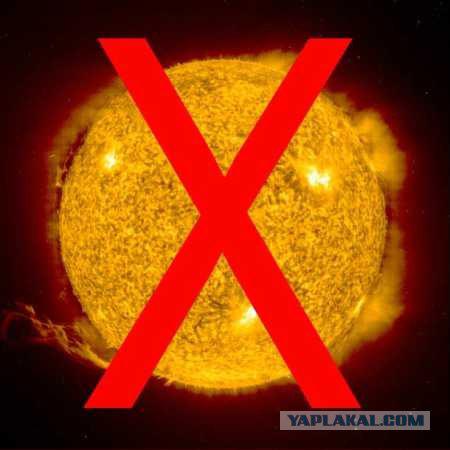
On the Earth is getting warmer. And it is not due to man-made human activity (although there is also clearly not all), namely, the laws of physics. In the solar core hydrogen into helium, which accumulates as temperature and solar mass enough for further reaction involving already helium. Over time, the amount of helium "ash" in the Sun increases, and under the influence of its mass, helium starts to shrink, heating and warming up the core of the sun. The cosmic scale, this means that over time the sun becomes hotter and bright. Since its "on" for more than 4 billion years ago, the sun has become brighter by almost half, and this process continues.
Everything seemed to be going very slowly, and we are in the world to be afraid it is too early, but if the annual average temperature on Earth will increase by some a couple of degrees, can the global melting ice caps at the poles that would flood large areas of land. Over time, Antarctica will be a very popular resort for relaxation, as it is now Hawaii If you look at two billion years into the future, we will see that the oceans in the world simply do not have - they have evaporated due to the heat radiation from the land of "hot" sun. And it is irreversible ...
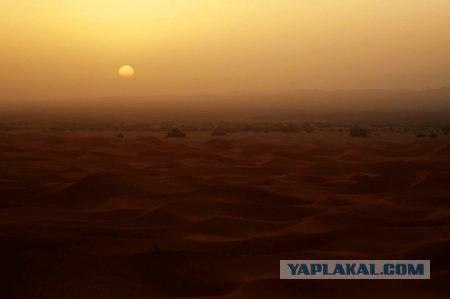
It would seem that what could be worse? Scientists say - even as you can! Now the Sun's core is constantly formed vast strata of helium, which is compressed under its own weight by 30 meters a year, and it accumulate more and more layers of helium. Eventually the outside there will be only a thin (comparative) layer of hydrogen which is heated to such an extent that it will begin to expand the shell of the rubber bulb. So, what we have? Inside - hot helium core, outside - a thin layer of hot hydrogen, which is a fusion reaction, extending his.
This process will be visible only after 5-6 billion years, and then for "some" 700 million years the sun by hydrogen will start to increase to 2.5 times the diameter relative to its current size. Hydrogen will no longer heat the inner layers of inert helium, which is why there will be complex processes (I will not go into details) that will lead to a significant increase in the diameter of the Sun - more than 100 times, and its gradual cooling. The sun will become a red giant ... In the process of converting light will "flatten" its outer layers will periodically "shoot" and fly into the surrounding space, and then the Sun will be hot helium balloon the size of Earth and a mass of half the mass of modern sun. The resulting blue dwarf (the name to refer to such stars) will gradually cool down, as a thermonuclear reaction it most will not occur. The cooling process is delayed for many billions of years, until the Sun will remain cold ball of dead matter ...
And what about the Earth? If it does not absorb the expanding sun, its surface will turn into an ocean of molten rock, and did live, of course, on her left. The only way for us to survive - to find a new home, or move the earth to another star. But this is, as you know, is another story.
via mindhobby.com

Source:
The most advanced can answer - Sirius.
The answer is not entirely true, because Sirius is the brightest star in the night sky, and the day is, of course, the sun!
Sun - one of many stars in our galaxy, more or less commonplace (more on that later), but feature him in close proximity, which is why it is not only light, but also warms us, and even look at him without the safety devices is dangerous (this is also below).

If you look at the sun, you can go blind. This tells us a child mother, father, relatives and friends: do not look at the sun, go blind! Actually, that's not true. To be exact, no one was blind, completely and forever, just looking at the sun. You can damage your eyes, but with the help of medications and special exercises vision largely restored. In addition, the most harmful to look at the sun during a total eclipse it, not when it shines with full force. It is dangerous to look at the sun without protection at the time immediately after the eclipse - when the light is completely covered by the Moon, the pupil increases, allowing more light into the eye, and if at this point sharply breaks first bright beam of light, you can get damage to the retina - solar retinopathy. It does not influence the thermal and photochemical when exposed to ultraviolet light flow through the pupil as open as possible is a chemical destruction of the cells of the retina. But even this harm can be eliminated with the help of medicine, almost completely restore vision in most cases. The risk in this regard are primarily children due to the nature of the structure of the lens of children's eyes (he transmits more blue light, the lens yellows with age, becoming a natural filter UV). For those of you who are determined to test and disprove the assertion of the impossibility of going blind staring at the sun, I can advise to use binoculars or a telescope - it will be more reliable, and if "lucky", you can get a premium Darwin

Sun - the most common star. Or not? Despite the fact that in recent years with the development of technology, many believe it is a 100% fact, actually the sun is different from the other stars in the galaxy. If you compare the lot of stars, they have one thing in common - they all have a spherical shape, more or less correct. However, they differ in size, temperature, color, luminance and other characteristics. All these different characteristics are the result of just one factor - mass. Weight stars defines all the parameters of the star - the size, the color, the term of her life, etc. Stars with low mass (less than half of the Sun), cold, dull, their color is closer to red, with a long life. Stars whose mass is 10-20 times larger than the Sun, mostly bright blue, very bright, but for a couple of million years, "burned" completely. The percentage of supermassive stars in the Galaxy can be counted on the fingers, a much more massive, and "small" - countless. Our Sun is then in the middle of the scale, and it is more massive than 80% of all stars in our Galaxy. Of course, if you look at the left drawing the title of the item, we can see that compared to the red giant Aldebaran sun looks like a dwarf, but such whoppers in the universe is a unit, so the right side of the figure, where the sun is compared to the more common brown dwarf (Star Style) to be more honest, because of dwarfs around us in the universe is the vast majority. Simply put, 90 percent of the stars that can be seen in the night sky, less dimmer and cooler than the sun.

So, the sun bright and large. Why is this so? What makes the sun is shining and warm, so much so that in the world at the same time the heat is 35 degrees in the shade? All the matter in the equation of Albert Einstein, E = mc2, according to which the conversion of the substance in en mass of the Sun is a million times the mass of Earth, the pressure at the center of more than 340 billion atmospheres, the temperature of 16 million degrees Celsius. Under these conditions inside the Sun occurs nuclear fusion, in which hydrogen is converted into helium - the same processes occur in the hydrogen bomb. However, there is only enough hydrogen out to inflate the balloon, and imagine what the reaction of burn millions of tons of matter ... When the hydrogen is converted into helium, the mass of matter is converted into energy that heats the sun. According to calculations, every second in the interior of the sun is converted into the energy of matter 5 million tons of material - a mass of seven fully loaded supertankers. More specifically, of the 700 million tons of hydrogen per second produced 695 tons of helium, and the missing 5 million tons of matter are transformed into 400,000,000,000,000,000,000,000,000 joules of energy, reducing the mass of the Sun on 0.00000000000000000025%. So in the next billion years, the Sun shortage of fuel is not threatened.

The sun is not visible from a distance of 60 light years. Despite all the turbulent energy and activity in its depths, and the unbearable brightness of our light can not be seen with the naked eye in the sky, if you fly off from it at some 60 light-years. In astronomy for the observed brightness of the star is the concept of magnitude, the minimum value of which, visible eye is 6. The higher the number, the more dim starlight. For example, the full moon has a value of minus 13, minus 4 Venus, one of the brightest stars - Vega has magnitude 0, Polaris - 2. The farther away from the object, the less bright it is visible in the sky. The brightness of the sun drops to sixth magnitude at a distance of 60 light years, or 600 billion kilometers. It is very far in human terms, but the scale of the universe is within arm's length. For comparison - the diameter of the Milky Way's 100,000 light-years, or 1, 000, 000, 000, 000, 000, 000 kilometers. The image of the Milky Way at the top 60 light years is less than half the pixels (dots on the screen).
The galaxy is huge. If you look at the sky at night, nearly all the stars that you see, are less than 100 light years from Earth, and only a few of them are so bright that "finishing off" from a greater distance. So if you put the sun in a random place of the universe, then the probability of 99.99999% to the naked eye will find it impossible.

What color is the sun? Many others will respond - yellow. But in reality the sun radiates throughout the range of visible colors from red to violet. The contribution of each color in the light varies, the maximum falls in the blue-green part of the spectrum, but the sun, we do not think green, because our brain combines different colors, forming a total color that seems to us the yellow (or not?).
Technically white sun. It is easy to prove - if you put in the open sunlight white paper, it will be just white, like snow or clouds. If the sun was shining yellow, the clouds, the snow and the paper would appear yellow, like many things around us. Despite this, many people perceive sunlight as yellow, on which are lengthy discussion and study of the human mind and vision. The reasons for this phenomenon is called a lot - a contrast to the blue sky, filtering light in the atmosphere, the effect of the yellow afterglow on the retina exposed to bright white light, etc. It's hard to say for sure, probably, everyone sees differently.

On the Earth is getting warmer. And it is not due to man-made human activity (although there is also clearly not all), namely, the laws of physics. In the solar core hydrogen into helium, which accumulates as temperature and solar mass enough for further reaction involving already helium. Over time, the amount of helium "ash" in the Sun increases, and under the influence of its mass, helium starts to shrink, heating and warming up the core of the sun. The cosmic scale, this means that over time the sun becomes hotter and bright. Since its "on" for more than 4 billion years ago, the sun has become brighter by almost half, and this process continues.
Everything seemed to be going very slowly, and we are in the world to be afraid it is too early, but if the annual average temperature on Earth will increase by some a couple of degrees, can the global melting ice caps at the poles that would flood large areas of land. Over time, Antarctica will be a very popular resort for relaxation, as it is now Hawaii If you look at two billion years into the future, we will see that the oceans in the world simply do not have - they have evaporated due to the heat radiation from the land of "hot" sun. And it is irreversible ...

It would seem that what could be worse? Scientists say - even as you can! Now the Sun's core is constantly formed vast strata of helium, which is compressed under its own weight by 30 meters a year, and it accumulate more and more layers of helium. Eventually the outside there will be only a thin (comparative) layer of hydrogen which is heated to such an extent that it will begin to expand the shell of the rubber bulb. So, what we have? Inside - hot helium core, outside - a thin layer of hot hydrogen, which is a fusion reaction, extending his.
This process will be visible only after 5-6 billion years, and then for "some" 700 million years the sun by hydrogen will start to increase to 2.5 times the diameter relative to its current size. Hydrogen will no longer heat the inner layers of inert helium, which is why there will be complex processes (I will not go into details) that will lead to a significant increase in the diameter of the Sun - more than 100 times, and its gradual cooling. The sun will become a red giant ... In the process of converting light will "flatten" its outer layers will periodically "shoot" and fly into the surrounding space, and then the Sun will be hot helium balloon the size of Earth and a mass of half the mass of modern sun. The resulting blue dwarf (the name to refer to such stars) will gradually cool down, as a thermonuclear reaction it most will not occur. The cooling process is delayed for many billions of years, until the Sun will remain cold ball of dead matter ...
And what about the Earth? If it does not absorb the expanding sun, its surface will turn into an ocean of molten rock, and did live, of course, on her left. The only way for us to survive - to find a new home, or move the earth to another star. But this is, as you know, is another story.
via mindhobby.com

Source:
